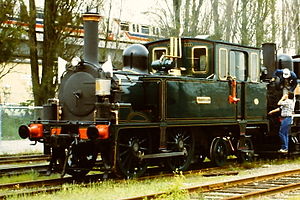Sharp Stewart 0-4-4T Dunrobin
In 1870 the 3rd Duke of Sutherland financed the extension of the Highland Railway line from Golspie to Helmsdale via his own Dunrobin Castle. In return he received his own private station for his castle (still in use today as a public station on the line from Inverness to Thurso). He also received the powers to run his own train on the lines owned by the Highland Railway. He had his own carriages and locomotive built for the purpose.
Dunrobin is an 0-4-4T, built by Sharp Stewart & Co of Glasgow in 1895 to order number E1056. One of the unique features was the enlarged footplate and enclosed cab with a 4 person upholstered seat set high up at the back. It was used until around 1920 to pull the Duke’s private train between Dunrobin Castle and Inverness. In 1949, the new British Railways revoked the powers of the Duke to travel in his own train.[1]
Contents
Preservation
Dunrobin and a saloon were sold in 1950 to the Romney, Hythe and Dymchurch Railway. The locomotive ran large parts of the 700+ mile journey (from Helmsdale to Carlisle and from Ashford to New Romney) under its own steam.[2] The locomotive was exported to Canada in 1965, but acquired in January 2011 by the Beamish Living Museum of the North[3] and repatriated to the UK. On arrival, Dunrobin was brought to Bridgnorth on 19 May 2011 to be dismantled and the feasibility of restoration to working order assessed. Contracts were subsequently let to Severn Valley Railway Engineering Services for boiler and mechanical overhaul at Bridgnorth Loco Works.
Current status
Progress on the overhaul saw work on the locomotive's rear bogie truck completed, and work on the chassis. By early 2018 the boiler boiler was largely complete (and awaiting assembly), with a great deal of new material incorporated including new barrel, firebox outer wrapper skirts, all new stays, new longitudinal and palm stays, overhauled dome, new smokebox and new internal components such as the J pipe also being replaced.[4] New tanks were completed at Dinas.
When Beamish bought the locomotive they could see some cracks in a small number of spokes. Once these were stripped at Bridgnorth, a great deal more cracks were revealed, to the extent that an independent inspection was commissioned using the magnetic particle inspection technique. The renewal of all four ‘driving’ wheels (coupled wheels) was instigated in 2018, the crank axle being retained, whilst the rest (wheel centres, tyres, front axle and crankpins) entirely new manufactured at South Devon Engineering.
A new cylinder block was commissioned and cast in 2014, however issues required remedial attention. By March 2019 the reworked block was awaited, before rewheeling could commence.[5] The project had been making slow but steady progress, with parts being reassembled, until being placed on hold in March 2020 due to the Coronavirus pandemic.
In May 2021 Beamish Museum announced they had received a grant of £150,000 to complete the work and was waiting for the SVR to allocate it a place in their workstream. The work to this point had been chassis-focussed, with the aim being to install the new cylinder block and wheel Dunrobin, before completing the boiler (which was nearly finished) and final assembly.[6]
Work recommenced at Bridgnorth in Autumn 2022, with Dunrobin re-entering the Loco workshops at Bridgnorth.[7] In June 2023 an important milestone was reached with the re-wheeling of the chassis after a number of years on an accommodation bogie.[8] This followed the fitting of the new cylinder block and alignment of slide bars. Yet more new metal is the replacement of the bunker and rear-cab section: the SVR sub-contracted the construction to the Ffestiniog & Welsh Highland Railway, who had earlier made the new tanks.[9]
Beamish Transport Online blog has regular updates on progress of the work.
The photograph below shows work in progress in March 2012.
Highland Railway Drummond “W” Class
The Highland Railway Drummond “W” (or "397"?) class comprised four locomotives built in 1905–1906 and were built to a similar design, the last engines built at Lochgorm works in Inverness. The LMS gave them a power classification '0P'. Two survived to 1956/7, the last HR locos in service. Two GWR 1600 Class 0-6-0PT locomotives (1646/49) took over the work from Helmsdale - Dornoch line.
See also
References
- ↑ Valkoinen, C., 'Dunrobin – The Little Royal Engine', National Railway Museum, 28 May 2014 Retrieved 15 August 2018
- ↑ Journal of The Stephenson Locomotive Society for August 1950, via Scotland Rail Holiday website (Retrieved 31 March 2024)
- ↑ Beamish announcement
- ↑ SVR News No. 199 and 200, Autumn and Winter 2017
- ↑ SVR News 205
- ↑ Beamish Transport Online blog, DUNROBIN – TEN YEARS ON, Paul Jarman, 19 May 2021
- ↑ Beamish Transport Online blog 22 October 2022 (Retrieved 2 November 2022)
- ↑ Branch Lines June 2023
- ↑ Beamish Transport Online blog, T&I NEWS 11 2023, and 2 2024, 27 May 2023 and 29 February 2024 (Retrieved 31 March 2024)

